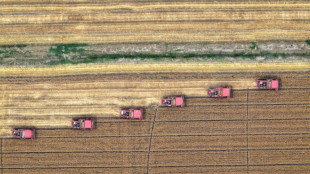
-
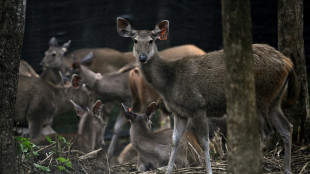 Thailand credits prey releases for 'extraordinary' tiger recovery
Thailand credits prey releases for 'extraordinary' tiger recovery
-
Can NATO keep Trump on-message about Russia threat?

-
 Australia drop struggling Labuschagne for first West Indies Test
Australia drop struggling Labuschagne for first West Indies Test
-
European, Iranian diplomats to meet as US mulls joining Israel campaign

-
 Paris makes clean water bet for River Seine bathers
Paris makes clean water bet for River Seine bathers
-
Jeeno Thitikul edges clear as heat takes toll at Women's PGA

-
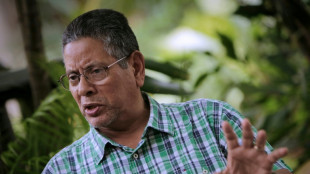 Critic of Nicaragua's Ortega shot dead in exile in Costa Rica
Critic of Nicaragua's Ortega shot dead in exile in Costa Rica
-
Barrios double gets Atletico back on track

-
 World No. 1 Scheffler shares lead at PGA Travelers Championship
World No. 1 Scheffler shares lead at PGA Travelers Championship
-
Messi's 'winning spirit' surprising: Inter Miami's Mascherano

-
 US immigration agents barred from LA Dodgers' stadium: team
US immigration agents barred from LA Dodgers' stadium: team
-
SpaceX Starship explodes on Texas launch pad

-
 Messi strikes as Inter Miami stun Porto at Club World Cup
Messi strikes as Inter Miami stun Porto at Club World Cup
-
US immigration agents barred from LA baseball stadium: team

-
 Jorginho gunning for old side Chelsea with Flamengo at Club World Cup
Jorginho gunning for old side Chelsea with Flamengo at Club World Cup
-
Real Madrid star Mbappe released from hospital

-
 World No.1 Sinner shocked in Halle second round by Bublik
World No.1 Sinner shocked in Halle second round by Bublik
-
Chelsea boss Maresca 'trusts' Mudryk after doping charge

-
 Israel welcomes 'all help' in striking Iran, Trump to decide 'within two weeks'
Israel welcomes 'all help' in striking Iran, Trump to decide 'within two weeks'
-
Zverev holds off Sonego to reach Halle quarter-finals

-
 Palmeiras ease past Al Ahly in Club World Cup
Palmeiras ease past Al Ahly in Club World Cup
-
Alcaraz survives scare to reach Queen's quarter-finals

-
 Stokes adamant Archer 'desperate' for England return
Stokes adamant Archer 'desperate' for England return
-
Palmeiras v Al Ahly Club World Cup clash suspended for weather

-
 French Open winner Gauff falls at first hurdle on Berlin grass
French Open winner Gauff falls at first hurdle on Berlin grass
-
Cleanup begins as Hurricane Erick moves on from Mexican coast

-
 Restoration rejuvenates iconic Gaudi house in Barcelona
Restoration rejuvenates iconic Gaudi house in Barcelona
-
Trump 'Golden Dome' plan tricky and expensive: experts
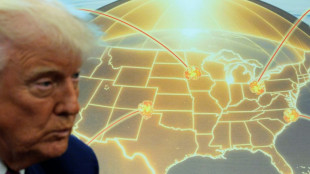
-
 French state leads capital increase for satellite operator Eutelsat
French state leads capital increase for satellite operator Eutelsat
-
Russia steps out from shadows in Africa with state paramilitary

-
 Trawlerman and Buick move into top gear to land Ascot Gold Cup
Trawlerman and Buick move into top gear to land Ascot Gold Cup
-
France softens restrictions for Telegram founder Durov: judicial source

-
 Trump extends deadline for TikTok sale by 90 days
Trump extends deadline for TikTok sale by 90 days
-
Indonesia leader touts growing Russia ties after talks with Putin
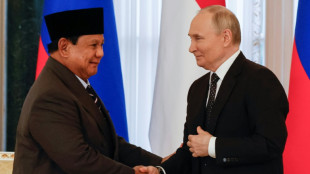
-
 Czech champion Kvitova calls time on tennis career
Czech champion Kvitova calls time on tennis career
-
Test series win in England bigger prize than IPL, says India captain Gill

-
 Sabalenka back to winning ways in Berlin
Sabalenka back to winning ways in Berlin
-
Mahuchikh, Holloway headline Paris Diamond League

-
 How did life survive 'Snowball Earth'? In ponds, study suggests
How did life survive 'Snowball Earth'? In ponds, study suggests
-
Russell signs new deal at Premiership champions Bath

-
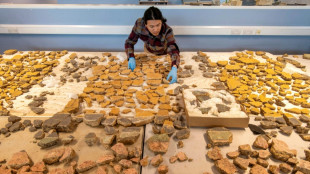 2,000-year-old Roman wall paintings unearthed in London
2,000-year-old Roman wall paintings unearthed in London
-
Tourists, fishermen hunker as Hurricane Erick pounds Mexican coast
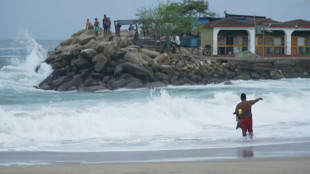
-
 How Trumponomics has shaken global markets
How Trumponomics has shaken global markets
-
Sabalenka back to winnings ways in Berlin

-
 Real Madrid star Mbappe hospitalised with stomach bug
Real Madrid star Mbappe hospitalised with stomach bug
-
Dropping Pope for India Test would have been 'remarkable', says England's Stokes

-
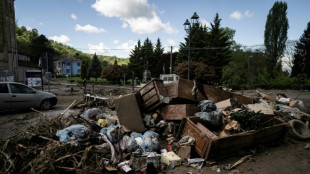 Climate change could double summer rainfall in the Alps: study
Climate change could double summer rainfall in the Alps: study
-
If Iran's Khamenei falls, what would replace him?

-
 India's Bumrah aiming for three Tests out of five against England
India's Bumrah aiming for three Tests out of five against England
-
Mutilation ban and microchips: EU lawmakers approve cat and dog welfare rules


In US national parks, a historical wound begins to heal
When Raeshaun Ramon first donned the distinctive green and gray uniform of a US National Park Service ranger, he feared his Native American tribe would judge him for his choice.
As a member of the Tohono O'odham nation, he didn't want to talk too much about his new job at Saguaro National Park in Arizona.
"I was afraid of what my people might think of me," the 28-year-old confides. "Why work for a place that has done us so much harm in the past?"
Most national parks were set up in areas that are Indigenous ancestral lands. From the 19th century onwards, Native Americans were expelled from those lands or forced to cede them via treaties with unequal terms.
It is a disturbing history not often associated with the natural beauty of the nation's parks.
Ramon is the first ranger at Saguaro to belong to the Tohono O'odham nation -- literally, the "desert people" -- even though the park is their historic territory.
Amid expanses of cacti, he tells AFP of his relief when his community rejoiced that "someone who looks like them" was finally represented at the park.
Today, he sees himself as a "bridge" between his colleagues, park visitors and his tribe, although he describes it as a "heavy responsibility."
His story illustrates the changes slowly underway within the National Park Service (NPS) -- the agency within the Department of the Interior in charge of national parks -- to improve its relations with Indigenous peoples.
For the first time, the agency's director is Native American -- a strong signal of the attempt to repair historical wounds.
- Traditional harvest -
"The visitors need to realize that this is Indian country," stresses Mike Turek, author of one of the few books on the relationship between Native Americans and the national parks.
"These are native lands, managed by the natives and used for centuries."
"The violence was a taking of the land," Turek says, adding that Indigenous access was restricted.
At Yellowstone, one of the crown jewels of the park system established in 1873, early administrators claimed that Native Americans had never entered the area for fear of geysers, Turek says.
In other cases, conflicts led to bloodshed. Shortly before the creation of Yosemite National Park, Native Americans were forcibly evicted or killed.
Today, the traditional use of land by these communities is one of the bones of contention, Turek says.
Jacelle Ramon-Sauberan, 35, also a member of the Tohono O'odham nation, recalls difficult interactions with Saguaro park employees who "shouted at them" when she and other family members came to pick the fruit of the cacti, considered sacred, during her childhood.
This tradition has been practiced by her people since "time immemorial," recounts Ramon-Sauberan, who has a doctorate in American Indian studies from the University of Arizona.
Syrup made from Saguaro cactus fruit is used for ceremonies and as medicine.
She said that the NPS even tried to ban harvesting of the fruit in the middle of the last century. Today, harvests are regulated by permits.
"I will truthfully speak that the relationship between the park and the Tohono O'odham wasn't always the best," she says. "It's a lot better than it used to be... We are heading in the right direction of really being partners with each other."
- Partnerships -
In 2021, Native American author David Treuer put forth a provocative idea in an article for The Atlantic magazine: "return the National Parks to the tribes," a move he wrote "would restore dignity that was rightfully ours."
For now, NPS Director Chuck Sams supports the development of partnerships.
There are currently some 80 co-management agreements between the NPS, in charge of more than 400 sites across the country, and some of the more than 500 Native American tribes currently active in the United States.
In northern Montana, Termaine Edmo takes part in the Native America Speaks program, which each summer brings members of her tribe, the Blackfeet Nation, to share their history with visitors to Glacier National Park.
But the 35-year-old activist, her eyebrows furrowed, speaks harshly of those who administer the land "stolen" from her people.
"They're still oppressing us," says Edmo, whose license plate begins with the letters "DECO," for "decolonization."
The past has left its mark: Native American reservations established for those driven from ancestral homes are predominantly poor and often wracked by high suicide and drug overdose rates.
Edmo regrets that so few visitors stop at her reservation, which is adjacent to the park, with the economic influx going to other towns.
As climate change coordinator for her nation, she would like to develop ecotourism to attract travelers to natural preservation projects, such as snow fencing, and regenerative grazing.
Despite all this, park officials are "trying to be open," she says. "They're willing to work with us. They're willing to step out of that box."
Last year, some 40 bison were reintroduced to repopulate the park.
- Rehabilitation -
New guidelines issued in 2022 aim to strengthen cooperative agreements which, according to Sams, should make it possible to "recognize the existence of deep wounds and hopefully heal some of them."
But they also aim to make better preservation decisions, drawing on deep tribal knowledge.
Recently, for example, Native American techniques of controlled burning -- to clear vegetation and avoid catastrophic fires -- have been re-established.
The increased hiring of Native American employees should also help bring change.
Of the 20,000 or so NPS employees, around 2.5 percent are American Indian or native Alaskan -- a figure that is "still remarkably low," the agency notes.
Ramon, the new ranger at Saguaro, would like to start by redesigning some information panels to include names in his traditional language, or because some signs "say that there was once a population living here" but "it stops there," he says.
"Visitors ask me: 'What happened to the people who lived here?' I smile at them and say: 'They're still here. Because I'm here.'"
M.Schneider--VB


